Current Conditions of the Northeast U.S. Shelf Ecosystem: Fall 2019 Update
A summary of temperature, salinity, chlorophyll and other conditions on the Northeast U.S. Continental Shelf during the first half of 2019.
Introduction
The Current Conditions is a biannual report on ecosystem and fisheries indicators for the Northeast U.S. continental shelf ecosystem. The report includes measurements of temperature and salinity indicators of seasonal warming and cooling patterns. Indicators describing phytoplankton distribution and blooms are derived from satellite remote sensing data. Upper trophic level indicators of fish and macroinvertebrate habitat and distribution dynamics are based on the Northeast Fisheries Science Center bottom trawl surveys.
Summary
- During the first half of 2019, sea surface temperatures in the Northeast U.S. Shelf Ecosystem continued to be moderate compared to the record high temperatures that occurred in 2012. However, based on contemporary satellite remote-sensing data and shipboard measurements, temperatures remain above the long-term average.
- The Gulf of Maine and Georges Bank 2019 winter-spring phytoplankton blooms were below average.
- Compared to recent years, the spring thermal transition dates for 2019 were near average.
- According to bottom trawl survey samples through spring 2019, fish and invertebrate species distribution has shifted to the northeast and into deeper water.
Temperature
Daily Sea Surface Temperature for the First Half of the Year
Daily sea surface temperatures were at or below average conditions during the first half of 2019. The Scotian Shelf ecoregion had the largest departures from average conditions. Early in the year, temperatures were approximately 2°C below the average in the Scotian Shelf area before returning to average temperatures by mid-year. In contrast, temperatures in the Middle Atlantic Bight, Gulf of Maine, and Georges Bank stayed close to average level through most of the first half of the year.

Sea Surface Temperature Trends for the First Half of the Year
Average sea surface temperatures for the first half of 2019 were generally at average levels in all ecoregions. However, thermal conditions have become more moderate since the record high temperatures observed in 2012. Though the other ecoregions’ linear trends indicate increasing temperatures, none of them appear to be significant. However, all areas show an abrupt change in temperature in the last decade, which may moderate with the 2019 data.

Trends in Variability of Sea Surface Temperature for the First Half of the Year
Sea surface temperature variability (the standard deviation) for the first half of 2019 increased in all ecoregions. The increase in variability appears to be significant in the Gulf of Maine and Scotian Shelf but not significant in the other areas. There were no clear-cut patterns in any change points in variability between areas.

Long-term Trends of Sea Surface Temperature for the First Half Year
The long-term temperature time series is derived from the Extended Reconstructed Sea Surface Temperature dataset. It provides a low-resolution depiction of sea surface temperature on the Northeast Shelf since the 1850s. The data is based on historical shipboard measures and augmented with other data in recent years. The temperatures for the first half of 2019 were above average and generally match conditions during the warm period of the late 1940s and early 1950s.
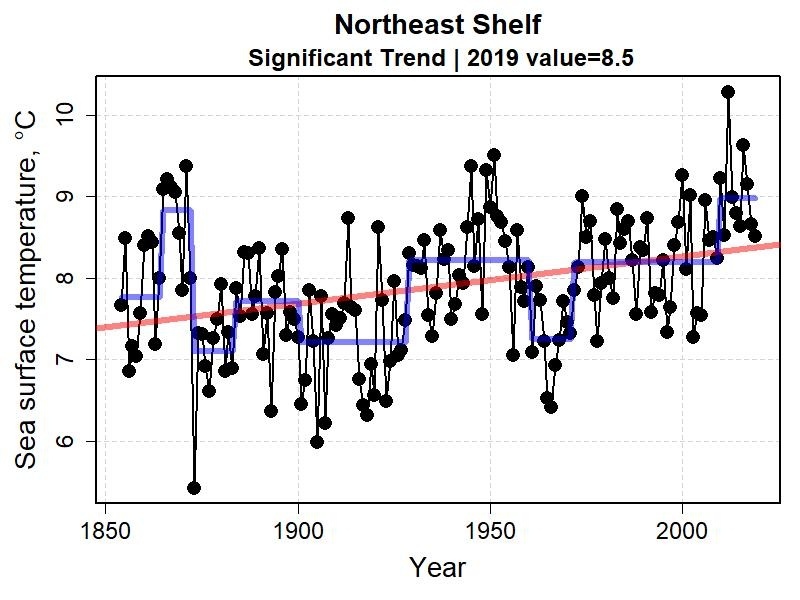
Bottom Temperature Trends for the First Half Year
The thermal conditions at the bottom of the water column are extremely important in defining the habitats for the majority of resource species. While sea surface temperatures can be measured by satellite remote sensors, bottom temperatures must be measured from ship surveys and other means. For this reason we often have incomplete spatial and temporal sample coverage to describe bottom water temperatures. The bottom temperatures for the first half of the year have been increasing in all ecoregions, but this trend appears to be significant only in the Scotian Shelf. There were no suggestions of any change points in temperature in the Middle Atlantic Bight. However, there were change points in the Scotian Shelf and Georges Bank areas around 2010.
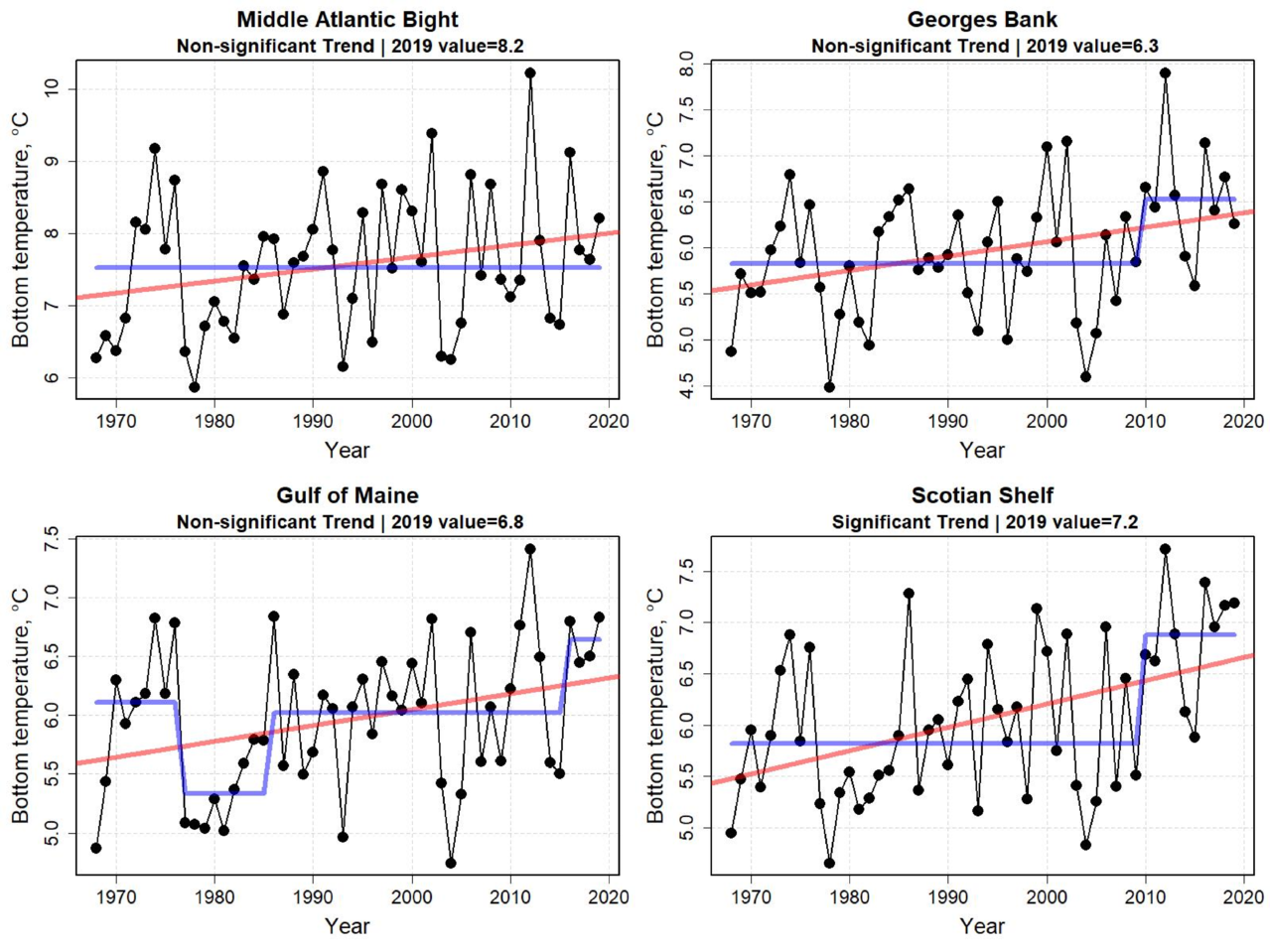
Spring Thermal Transition Day
Phenology is the climate’s influence on the timing between plant and animal production cycles. Many marine organisms time their reproductive cycles to make best use of seasonal phytoplankton blooms, like the spring bloom. In turn, temperature plays a role in the development of the spring bloom. Identifying the initiation date of the spring transition temperature, which varies by region, can help determine the average temperature between winter and summer.
The spring thermal transition date was relatively constant from 1982 to approximately 2010 for the Northeast Shelf ecoregions. A change point appears in all areas around 2010, when the spring transition date advanced approximately two weeks. The trend shift to earlier spring transition dates appears significant in the Gulf of Maine and Scotian Shelf regions.
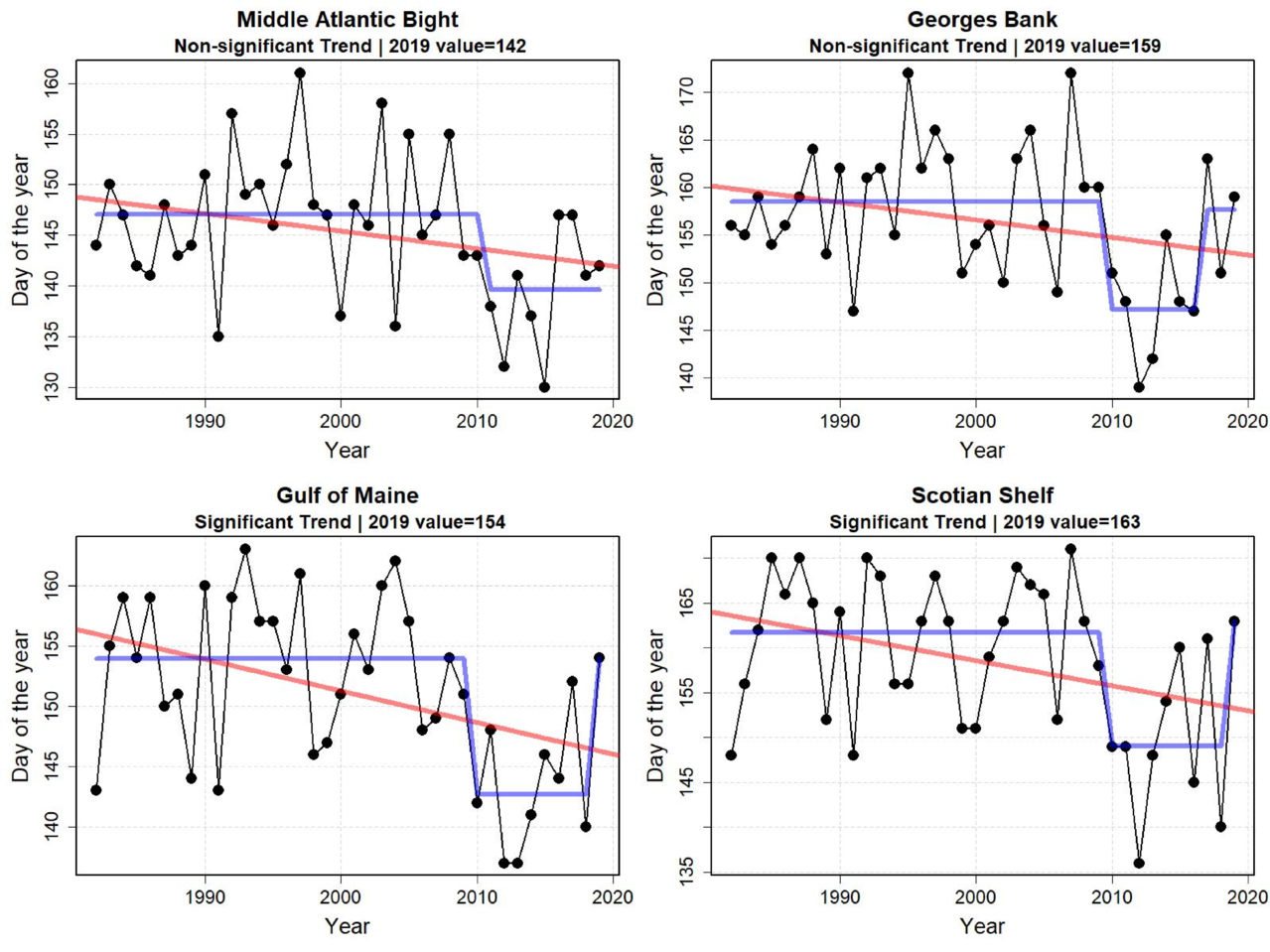
Salinity
Salinity and temperature can be indicators of the source water in the ecosystem.
Surface Salinity Trends for the First Half of the Year
Surface salinity, measured in practical salinity units, has increased in all ecoregions except Georges Bank. However, in some areas there appears to have been a regime shift in 2012, when salinities increased by approximately 0.5 practical salinity units. In all areas there is the suggestion that surface salinity decreased to below average levels in 2019.
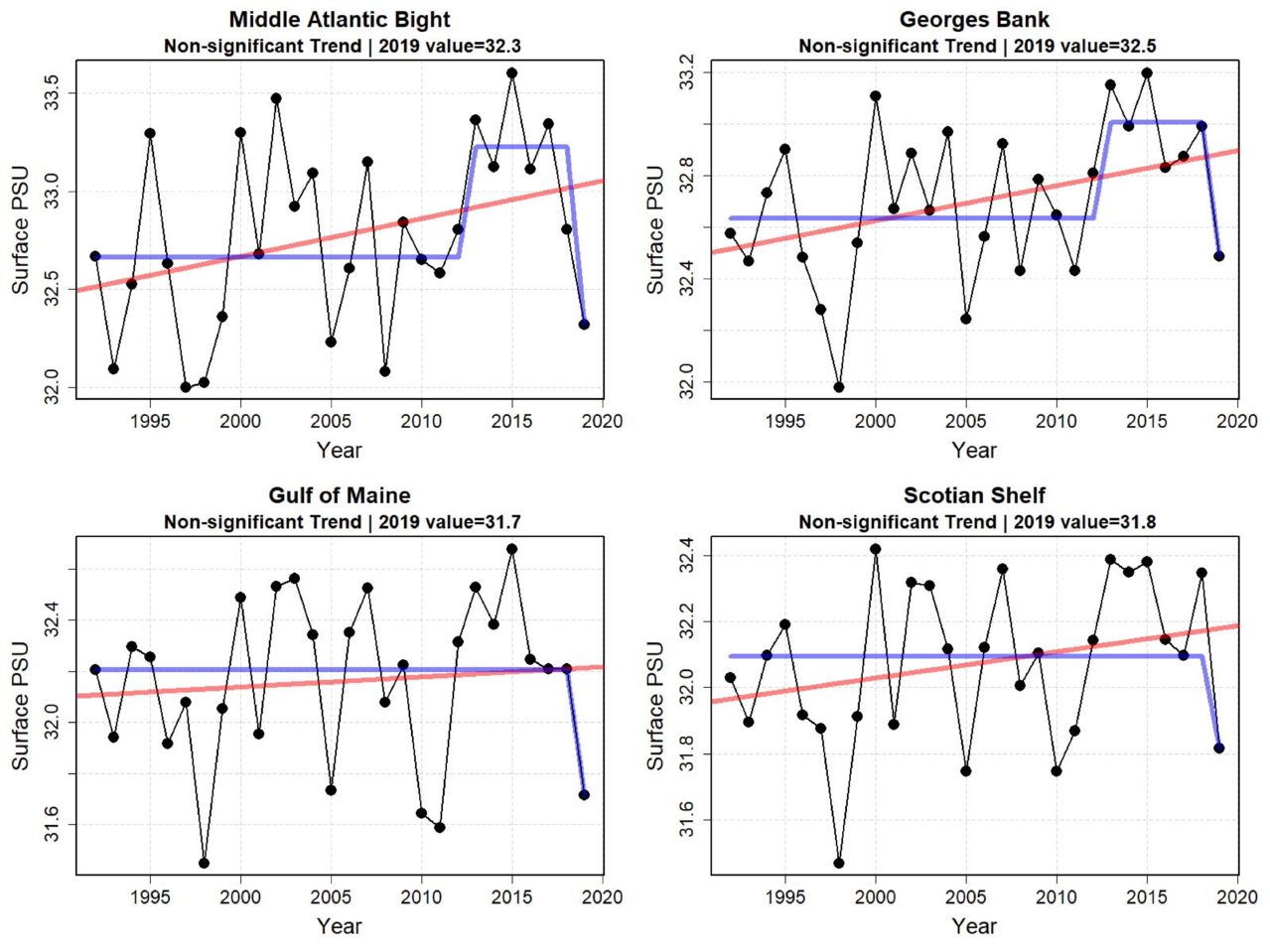
Bottom Salinity Trends for the First Half of the Year
Bottom salinity has increased in all ecoregions except the Gulf of Maine. In most regions there appears to have been a regime shift in 2012, as salinities increase by approximately 0.5 practical salinity units.

Chlorophyll Concentration
Weekly Chlorophyll for the First Half of the Year
Chlorophyll concentration was below average during the first half of 2019. In areas that typically have a spring bloom, such as Georges Bank, chlorophyll concentration was below the long-term average through the bloom period. The chlorophyll concentration for the Gulf of Maine spring bloom was above average for one week, but well below average for most of the bloom period.

Chlorophyll Concentration Trends for the First Half of the Year
Average chlorophyll concentrations during the winter-spring months appear to have decreased in recent years in all areas of the ecosystem. The most dramatic decline appears to have occurred in the Middle Atlantic Bight and the Gulf of Maine. It is noteworthy that we have identified a change point in chlorophyll concentration in all areas within the last decade or so.
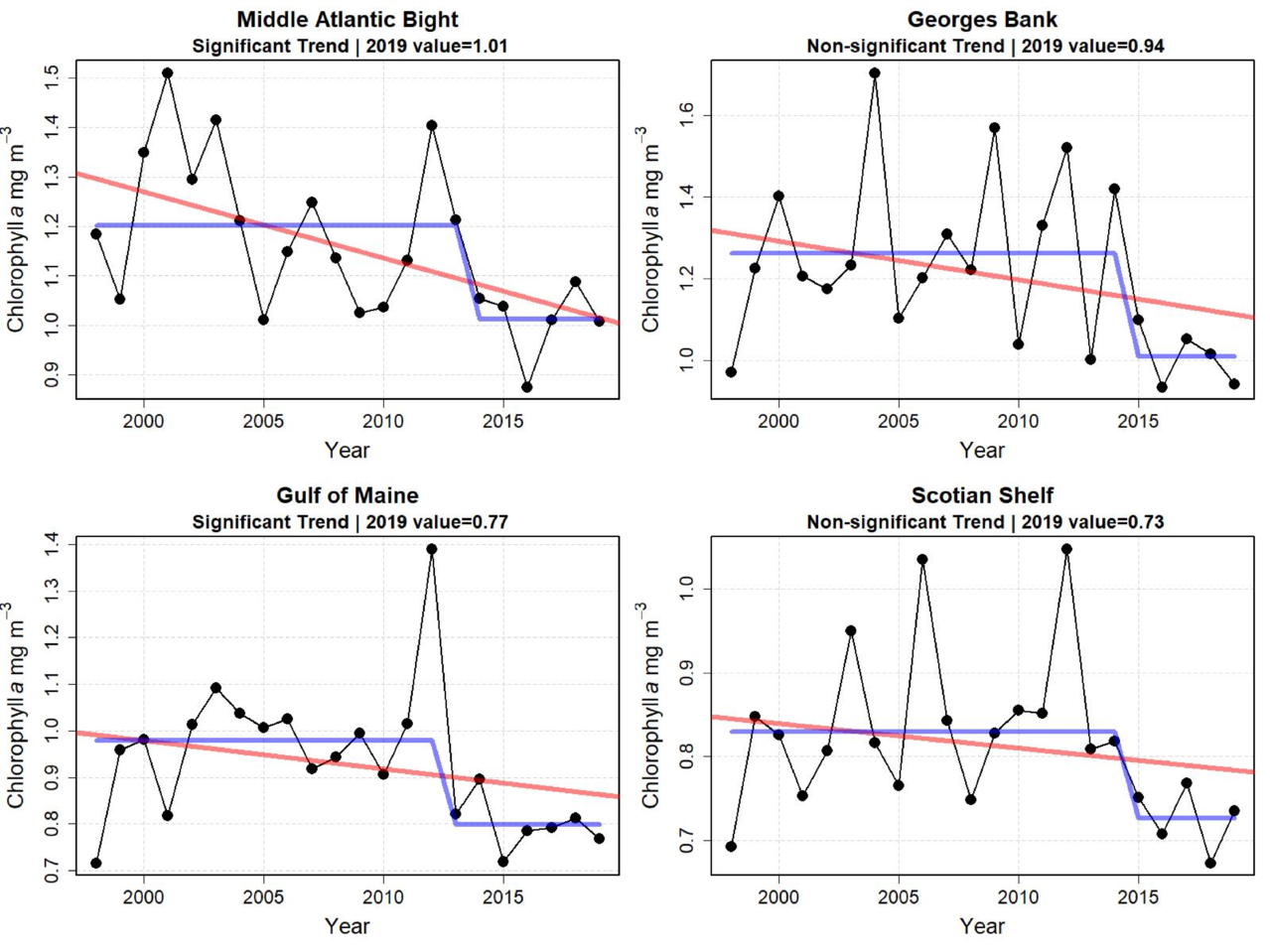
Trends in Species Distribution Metrics
Distribution of Northeast U.S. Shelf species has changed over recent decades. Individual species have shifted distribution for a number of reasons. We can characterize these shifts with the following metrics including the center of gravity of:
1. Depth
2. Distance to the coastline
3. Latitude
4. Longitude
5. Along-shelf position in the ecosystem along an axis oriented from the southwest to the northeast
The averages of these metrics for 48 of the more abundant Northeast Shelf species are shown in time series plots below. All these metrics have increased significantly with the exception of distance to the coast, indicating a continuing shift of species distribution to the northeast and into deeper water.
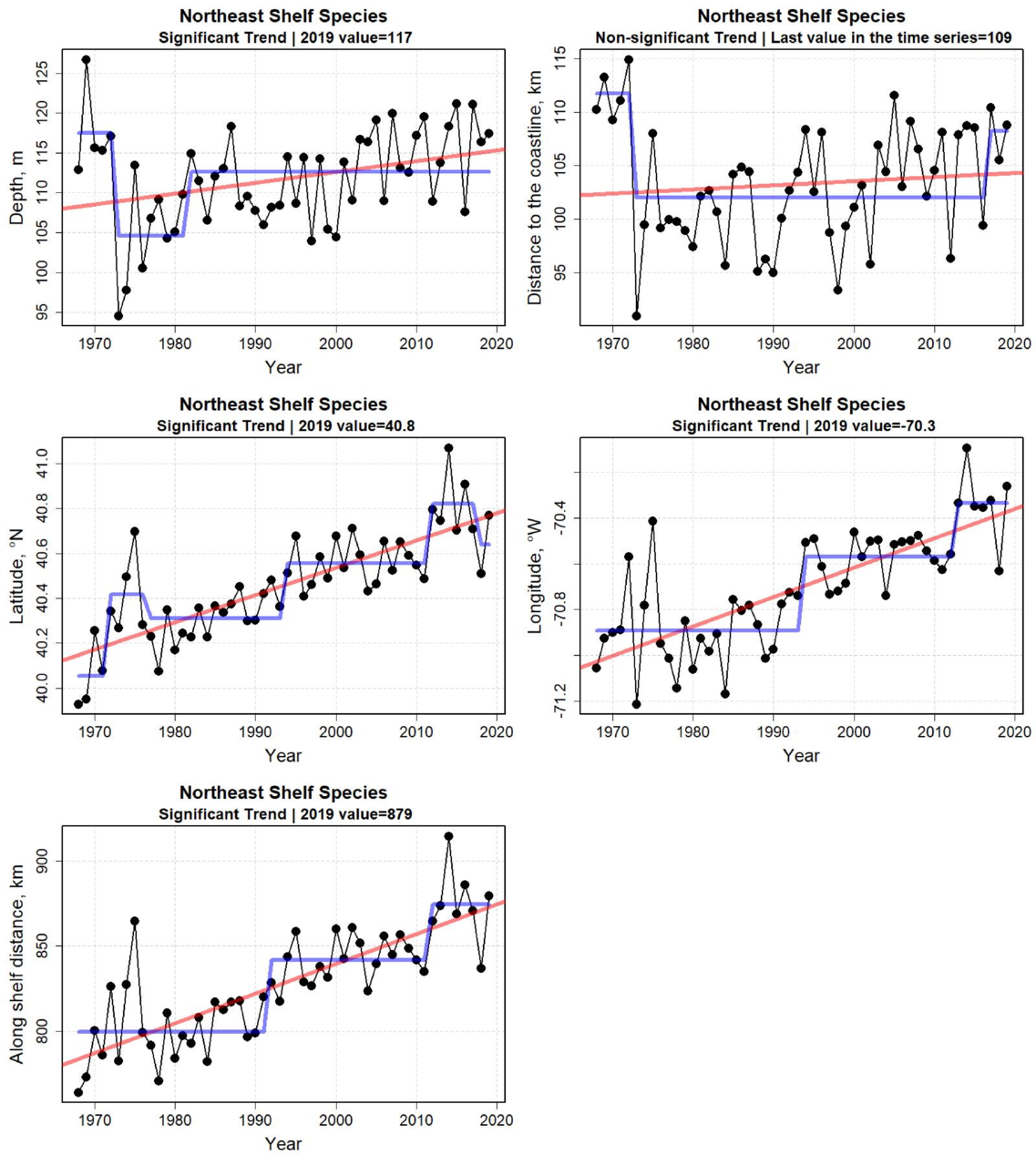
Trends in Fall Occupancy Habitat by Functional Group
Habitat or species distribution models provide estimates of the area a particular species would be likely to occupy based on their preferred habitat. We analyzed the output of a series of these models to determine the trends in the area of 50% probability of occurrence habitat by functional group. To ameliorate the effect of more abundant and widely distributed species, we processed the habitat area time series with principal component analysis to provide a single index that reflects the change among all members of the functional group. The trend among benthivores, demersal piscivores, and planktovores were all significant and positive (see graphs). The trend for pelagic piscivores was not significant.
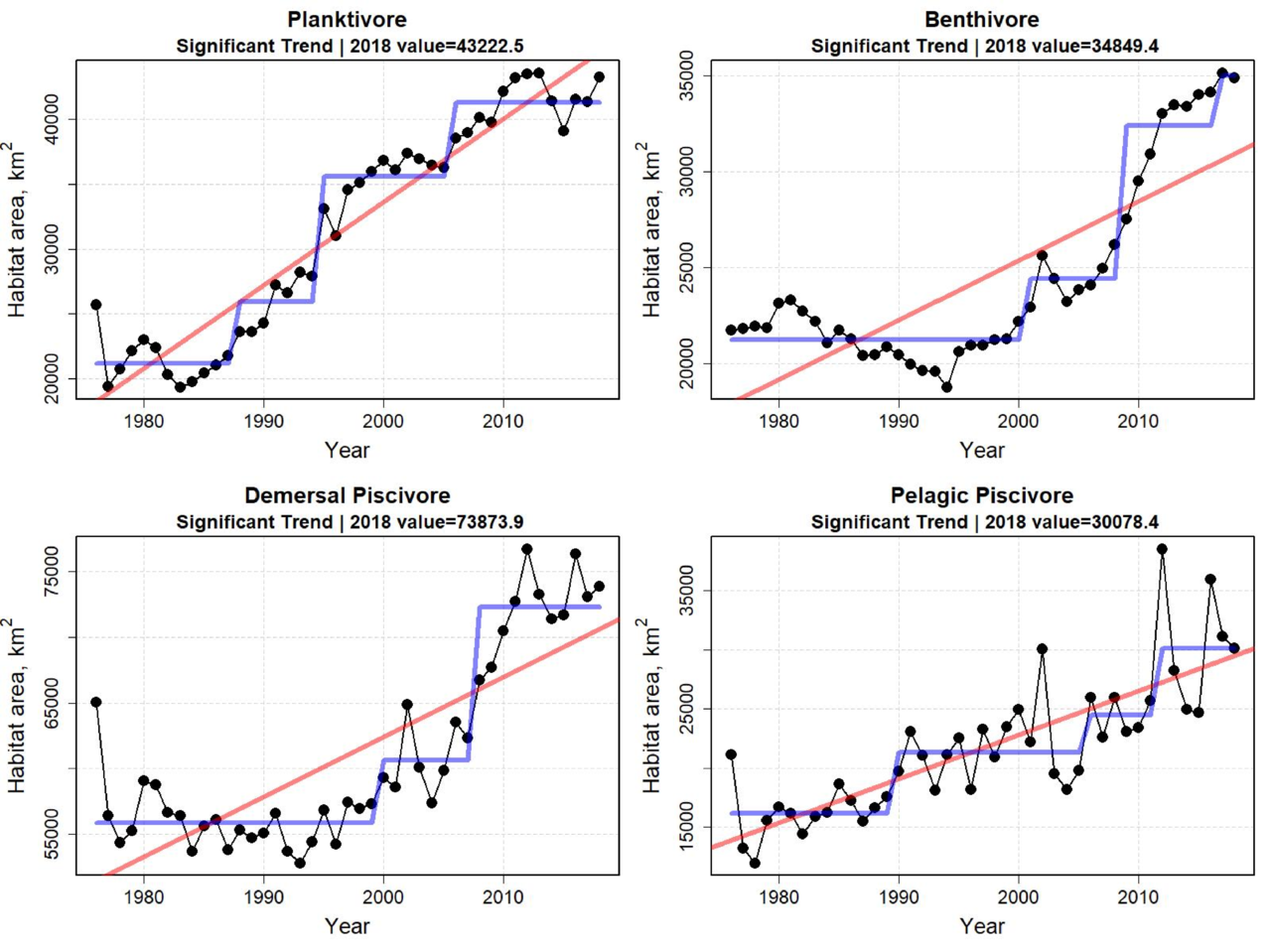
Ecosystem Forecast-Experimental Data Product
As weather and earth system models have improved, so have monthly forecasts over seasonal scales ranging up to seven months in advance. For each of the ecoregions of the Northeast Shelf, we provide forecasts from an ensemble of seven forecast models starting with estimates for November 2019 and ending in May 2020.
The forecasts suggest that the Northern ecoregions will have above average sea surface temperatures, while the Middle Atlantic Bight will progressively experience less elevated temperatures.
Learn more about these ecosystem forecasts
